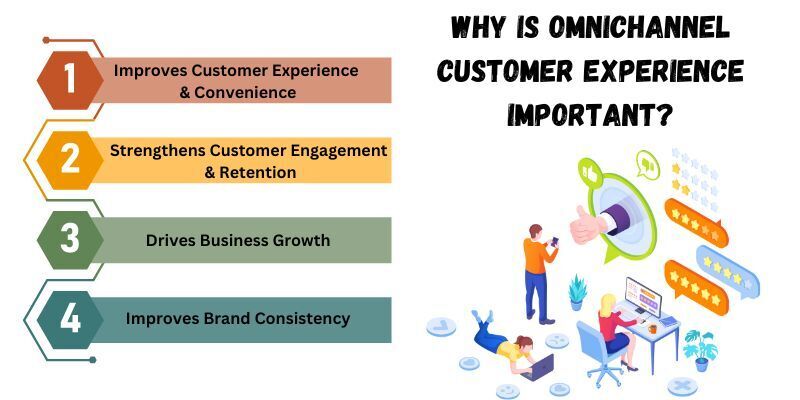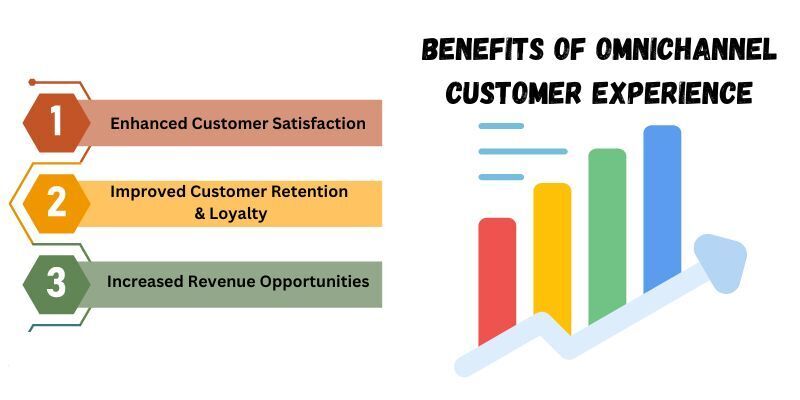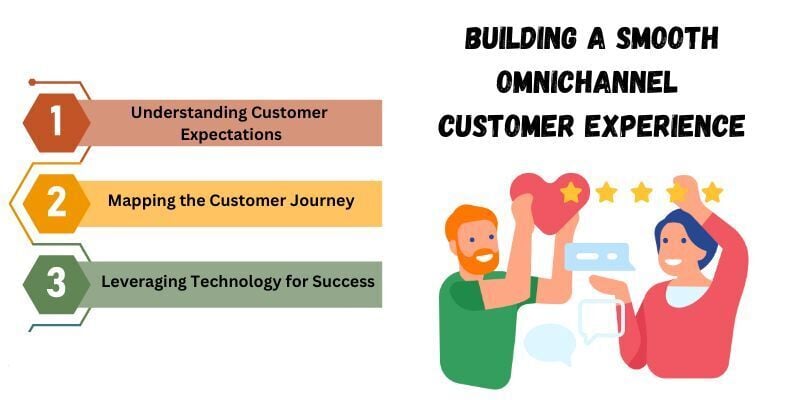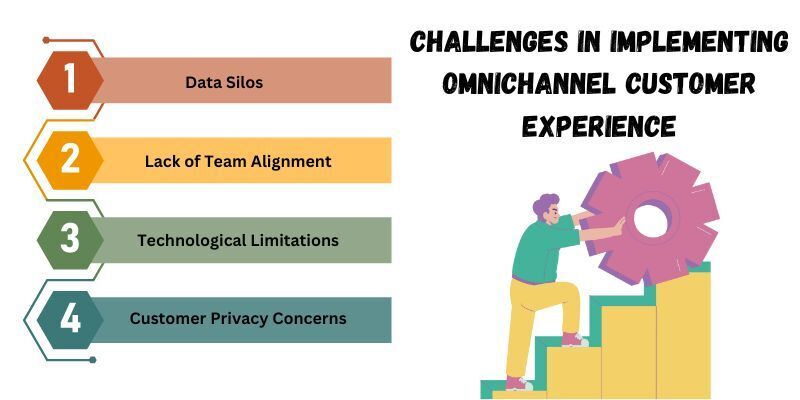The omnichannel customer experience (CX) is an integrated approach that ensures consistency across all touchpoints where a customer interacts with a brand.
This means the customer receives the same service, messaging, and experience, whether browsing a website, using a mobile app, chatting on social media, or visiting a physical store.
The omnichannel customer experience aims to provide a smooth and unified journey, increasing satisfaction by allowing customers to switch between channels without disruption.
Imagine a customer researching a product on a mobile app, adding it to their cart, and then completing the purchase in-store with the same information and pricing reflected across platforms. That’s the essence of omnichannel customer experience management.
This approach is essential for businesses looking to meet modern consumer expectations, as it increases satisfaction and retention.
As businesses adopt digital and physical channels to engage customers, providing an omnichannel experience can help build a stronger brand connection and lead to more effective customer interactions.
What is Omnichannel Customer Experience?
Omnichannel customer experience refers to integrating all customer touchpoints—physical and digital—into a streamlined, unified experience. The purpose is to provide customers with consistent and uninterrupted interactions with the brand, regardless of how they engage.
An omnichannel experience ensures that all parts of the customer journey connect smoothly, providing a continuous experience across platforms.
This approach differs from a multichannel strategy, where each channel operates independently. A customer’s experience might need consistency between touchpoints in a multichannel setup.
For example, an in-store promotion might not be reflected on the website, which needs to be clarified. On the other hand, an omnichannel experience ensures that all channels are integrated so that the in-store promotion appears online, in mobile apps, and even in email campaigns.
Characteristics of an Omnichannel Experience
Here are some key characteristics of a well-executed omnichannel customer experience:
- Unified customer data: An omnichannel customer experience system shares customer data across platforms, ensuring that interactions are recorded and used to provide a personalized experience.
- Consistent branding and messaging: A strong omnichannel experience ensures that customers see consistent messages, whether browsing a website, checking an email, or interacting with a salesperson in-store.
- Smooth transitions: The experience remains smooth whether the customer switches from a website to a mobile app, interacts on social media, or visits a brick-and-mortar location.
Example of Omnichannel Experiences
To fully understand what an omnichannel customer experience looks like in action, consider this scenario:
- A customer browses a clothing website and adds an item to their cart but needs to complete the purchase.
- Later, they receive an email reminding them of the item in their cart.
- They open the brand’s mobile app and find the item still in their cart, with the same promotion they had seen online.
- The customer decides to visit the store in person, where the salesperson can access their browsing and purchase history, allowing them to offer tailored recommendations.
This uniform journey reflects a practical omnichannel experience, where each interaction builds on the previous one, ensuring a cohesive and enjoyable process for the customer.
The Importance of Omnichannel Customer Experience
 The importance of an omnichannel customer experience must be addressed, especially in today’s fast-moving business world. With many brands competing for attention, businesses must offer a connected and aligned experience to stand out.
The importance of an omnichannel customer experience must be addressed, especially in today’s fast-moving business world. With many brands competing for attention, businesses must offer a connected and aligned experience to stand out.
When all customer touchpoints—whether online or in-store—work together smoothly, businesses have a decisive edge. Below, we explore why an omnichannel customer experience is crucial for success and how it can transform a business.
1. Improves Customer Experience and Convenience
Customers today expect their interactions with brands to be simple and hassle-free. Inconsistent service across channels or varying information can cause frustration and lead to a poor overall experience.
An omnichannel approach eliminates these issues by ensuring customers can transition smoothly between platforms, whether shopping online, using a mobile app, or visiting a physical store.
For instance:
Suppose a customer begins browsing on a website and later switches to the mobile app. In that case, the system should remember their browsing history and shopping cart, creating a cohesive and uninterrupted experience.
This approach makes life easier for customers, reducing their effort and boosting overall satisfaction.
2. Strengthens Customer Engagement and Retention
Delivering a connected experience across all touchpoints can significantly improve customer engagement with a brand.
When customers feel understood and valued, they are more likely to stay loyal. Conversely, disconnected service, such as repeating information or dealing with fragmented communication, can push customers toward competitors.
An integrated omnichannel system helps businesses maintain strong customer relationships by providing consistent and personalized service across channels.
- Targeted personalization: When leveraging customer data from multiple touchpoints, brands can offer tailored promotions or suggestions based on browsing or purchase history, encouraging ongoing engagement and interaction.
3. Drives Business Growth
A well-executed omnichannel experience improves customer satisfaction and loyalty and leads to significant business growth. Businesses can increase their conversion rates and market share by making the buying process simpler and more convenient.
Here’s how omnichannel experiences drive growth:
- Higher conversion rates: When customers can move effortlessly between touchpoints—like starting their journey on social media and completing a purchase in-store—they are more likely to buy. A smooth experience reduces friction, making it easier for customers to follow through with their purchases.
- New customer acquisition: Satisfied customers are the best form of advertising. Customers who have a positive, connected experience are more likely to recommend the brand to friends and family. Word-of-mouth referrals help businesses grow organically and expand their customer base.
When focusing on delivering a consistent experience across all channels, businesses create more opportunities for conversions and new customer acquisitions, leading to steady growth.
4. Improves Brand Consistency
In today’s marketplace, brand consistency is vital for building trust and recognition. With so many touchpoints available—websites, social media, mobile apps, and physical stores—it’s essential to ensure that all channels reflect the same tone, style, and information.
Customers are likelier to trust and stay loyal to a brand that offers a reliable experience wherever they engage.
- Aligned messaging: When all channels are unified, customers receive consistent communication, whether checking a brand’s email, visiting their website, or interacting with a salesperson in-store. This helps create a clear and cohesive brand image, strengthening the relationship between the business and its customers.
A business that delivers a solid and consistent omnichannel customer experience builds a unified brand image in its customers’ minds. This nurtures trust and keeps the brand top-of-mind, even in a crowded marketplace.
Benefits of Omnichannel Customer Experience
 Implementing an omnichannel customer experience system can transform a business’s operations, leading to a range of benefits for both the company and its customers.
Implementing an omnichannel customer experience system can transform a business’s operations, leading to a range of benefits for both the company and its customers.
It allows businesses to create more cohesive, personalized, and convenient interactions across all channels, whether online, in-store, or mobile apps.
This, in turn, strengthens customer relationships, boosts loyalty, and ultimately increases revenue. Let’s explore some of the most essential advantages of an omnichannel strategy.
1. Enhanced Customer Satisfaction
One of the most significant benefits of adopting an omnichannel experience is improving customer satisfaction. When customers can smoothly transition between platforms and devices, their interactions with the business become smoother and more enjoyable, leading to higher satisfaction levels.
- Smooth transitions: Customers value switching between platforms—such as moving from a website to a mobile app—without losing their place. A unified approach ensures that information such as shopping carts, browsing history, and customer preferences carry over from one channel to the next.
- Unified support: In an omnichannel customer experience, support is available across all channels, ensuring that no matter where a customer seeks help, they will receive consistent assistance. This means that whether a customer contacts the company via social media, a phone call, or live chat, they will receive the same level of service, making problem-solving faster and easier.
2. Improved Customer Retention and Loyalty
Customers are more likely to remain loyal When they have consistently positive interactions with a brand. An omnichannel customer experience helps retain customers by delivering personalized experiences and ensuring they feel understood.
- Personalization: By collecting data across multiple channels, businesses can offer tailored experiences, such as personalized product recommendations or promotions. This level of personalization nurtures stronger relationships between the customer and the brand. For example, if a customer frequently buys certain products, the company can recommend similar items or offer special discounts on their favorite categories.
- Consistency breeds loyalty: Customers who experience consistent, high-quality interactions across platforms are likelier to engage with a brand over time, strengthening their loyalty. When customers shop online, visit a physical store, or interact via social media, they expect the same level of service and product quality. When businesses deliver on this expectation, customers feel confident about returning.
3. Increased Revenue Opportunities
Businesses that provide a seamless omnichannel customer experience will likely see a revenue boost. Omnichannel experiences reduce friction in the customer journey and make it easier for customers to complete purchases, leading to higher conversion rates.
- Higher conversion rates: Customers who have a smooth experience across touchpoints—whether they start browsing on a mobile app and complete their purchase in-store or switch between social media and a website—are more likely to convert. Customers who experience fewer obstacles and interruptions are more inclined to finalize their purchases.
- Increased referrals: Satisfied customers recommend brands to their peers, contributing to new customer acquisition and further business growth. Word-of-mouth is a powerful marketing tool, and customers who enjoy a positive omnichannel experience are more likely to share their experiences with friends and family.
As businesses create better customer experiences, they open up new opportunities for sales, including upselling and cross-selling, which can further increase revenue.
Critical Differences Between Omnichannel and Multichannel
At first glance, omnichannel and multichannel strategies may seem similar. After all, both involve engaging with customers across various channels like websites, physical stores, and social media.
However, key differences distinguish them, and understanding these distinctions is crucial for businesses aiming to provide a truly seamless omnichannel experience.
What Is a Multichannel Experience?
In a multichannel strategy, a business utilizes several communication channels to interact with customers, but these channels operate in isolation.
The primary focus of a multichannel approach is to provide multiple ways for customers to engage with the business. However, the interactions are often disjointed, and the channels have limited integration.
For example:
- Customers browsing a company’s website may receive information different from what they find on the brand’s social media pages.
- A customer service agent on the phone might need to be made aware of an issue the customer raised via email.
While a multichannel approach provides more opportunities for engagement, the disconnected nature of the experience can frustrate customers and lead to consistency in service.
What Is an Omnichannel Experience?
An omnichannel customer experience, on the other hand, is a fully integrated approach. All channels are connected, and customer data is shared across platforms to ensure a consistent and cohesive experience.
This means customers can move effortlessly between channels without reintroducing themselves or repeating information.
For example:
A customer begins browsing on a mobile app and adds items to their cart. Later, they log in to the website to complete the purchase, and their cart is already populated with the items they selected earlier.
A customer calls customer support after sending an email. The support agent already has access to the email, so the customer doesn’t need to repeat the issue.
1. Integration vs. Independence
One of the most significant differences between omnichannel and multichannel strategies is the level of integration between the channels.
In a multichannel setup, each platform functions independently, whether it’s a website, mobile app, or in-store experience. This often leads to fragmented customer interactions.
In contrast, an omnichannel customer experience system integrates all platforms, ensuring customer data, interactions, and preferences are shared across every touchpoint. This allows businesses to provide personalized experiences and anticipate customer needs more effectively.
2. Customer-Centric vs. Channel-Centric
Another critical distinction is that multichannel strategies tend to be channel-centric, focusing on each platform’s individual performance.
Businesses may concentrate on optimizing their website, social media, or in-store experience separately, with little regard for how these channels interact.
An omnichannel experience, however, is customer-centric. The focus is on creating a unified experience around the customer’s journey, regardless of the platform they use.
This allows for more flexibility and personalization, as businesses can better anticipate customer needs by understanding their behavior across multiple touchpoints.
In summary, while omnichannel and multichannel strategies involve multiple communication channels, the key difference lies in the integration and customer focus.
When adopting an omnichannel customer experience management approach, businesses can provide a more cohesive and satisfying journey for their customers.
Building a Seamless Omnichannel Customer Experience
 Creating a seamless omnichannel experience requires strategic planning and an understanding customer expectations.
Creating a seamless omnichannel experience requires strategic planning and an understanding customer expectations.
To succeed, businesses must deliver a consistent, integrated experience across all platforms and touchpoints. Let’s explore the essential components of building a successful omnichannel customer experience system.
1. Understanding Customer Expectations
To build a convenient omnichannel experience, businesses must first understand their customers’ needs, preferences, and expectations. This requires gathering data from various touchpoints to understand how customers engage with the brand.
- Gathering customer data: Businesses should collect data on customer behavior, preferences, and pain points from all channels, whether online or in-store. This information is essential for delivering personalized experiences.
- Customer feedback: Actively seeking feedback from customers allows businesses to identify areas for improvement in their omnichannel customer experience management. Feedback can be gathered through surveys, online reviews, and social media interactions.
- Buyer personas: Creating detailed buyer personas based on customer data helps businesses better understand their target audience. This enables them to tailor the omnichannel experience to customer needs and expectations.
2. Mapping the Customer Journey
Mapping the customer journey is critical in building an omnichannel customer experience. This involves identifying key touchpoints where customers interact with the brand and ensuring a smooth transition between these touchpoints.
- Identify critical milestones: The first step in mapping the customer journey is identifying the different stages of the customer experience, from the initial point of contact to post-purchase engagement. These stages include online research, in-store visits, social media interactions, and customer support calls.
- Analyze interactions: Businesses should analyze how customers interact with each touchpoint to identify potential friction points. For example, customers may experience frustration if they have to repeat information when transitioning from online chat to phone support. A practical omnichannel experience eliminates these barriers by ensuring that customer data is shared across platforms.
- Identify opportunities for improvement: Once businesses have mapped the customer journey and analyzed interactions, they can identify opportunities to improve the omnichannel customer experience. This might involve streamlining specific processes, enhancing channel communication, or introducing new technology to support the experience.
3. Leveraging Technology for Success
Technology is at the heart of a successful omnichannel customer experience system. Businesses must integrate various tools and platforms to ensure customer data flows freely between channels, enabling a cohesive and smooth experience.
- CRM systems: Customer Relationship Management (CRM) systems are essential for maintaining a centralized database of customer interactions. These systems allow businesses to track customer behavior, preferences, and purchase history across all channels, enabling personalized engagement.
- Marketing automation tools: Marketing automation tools help businesses deliver consistent messaging across channels. For example, a customer who browses products online might receive an email reminder about their abandoned cart, followed by a personalized offer when they visit the store.
- Data analytics: Data analytics tools allow businesses to gain valuable insights into customer behavior. When analyzing data from various touchpoints, businesses can identify trends, preferences, and potential pain points, allowing them to optimize the omnichannel experience.
- AI and chatbots: Artificial Intelligence (AI) and chatbots can boost the customer experience by providing instant support and personalized recommendations. For instance, a chatbot can assist customers in navigating a website, while AI-driven recommendations can offer product suggestions based on browsing history.
When effectively leveraging technology, businesses can provide a smooth, data-driven omnichannel experience that meets the needs of today’s tech-savvy consumers.
Challenges in Implementing Omnichannel Customer Experience
 While the benefits of adopting an omnichannel customer experience are evident, businesses often face several challenges during implementation.From data silos to misaligned teams, these hurdles can make it difficult to create a genuinely uniform experience. Below, we explore some common challenges and how businesses can overcome them.
While the benefits of adopting an omnichannel customer experience are evident, businesses often face several challenges during implementation.From data silos to misaligned teams, these hurdles can make it difficult to create a genuinely uniform experience. Below, we explore some common challenges and how businesses can overcome them.
1. Data Silos
One of the most significant challenges in implementing an omnichannel customer experience system is the existence of data silos.
In many organizations, customer data is stored in separate systems for each channel, such as one system for in-store transactions and another for online purchases. This fragmentation makes it challenging to provide a unified experience.
- Solution: To overcome this challenge, businesses must invest in integrated systems that allow data to be shared across all platforms. CRM systems, for example, can centralize customer data, enabling a more holistic view of each customer’s interactions. Additionally, implementing cloud-based solutions can help ensure data is easily accessible and up-to-date across channels.
2. Lack of Team Alignment
Another common challenge is the need for more alignment between different business teams. For example, the marketing team may focus on online campaigns while the sales team concentrates on in-store interactions.
Proper communication and collaboration can lead to consistency in the omnichannel experience.
- Solution: To ensure team alignment, businesses should adopt a culture of collaboration and communication. Cross-functional teams that include representatives from marketing, sales, customer service, and IT can work together to develop and implement a cohesive omnichannel strategy. Regular meetings and collaborative tools can keep everyone on the same page.
3. Technological Limitations
Implementing an omnichannel customer experience system often requires the integration of multiple technologies. However, not all businesses have the resources or expertise to manage this complexity, leading to potential delays or gaps in the omnichannel experience.
- Solution: Businesses should carefully evaluate their technological needs and invest in scalable solutions that can grow with their business. Partnering with third-party vendors or consulting with experts in omnichannel customer experience management can help businesses navigate the complexities of integrating multiple systems.
4. Customer Privacy Concerns
As businesses collect more customer data to deliver personalized experiences, they must also address growing concerns about privacy. Customers want to know how their data is used and expect businesses to protect their personal information.
- Solution: To overcome privacy concerns, businesses should be transparent about their data collection practices. Clear privacy policies, opt-in consent forms, and feedback forms can help build trust with customers. Additionally, businesses must comply with data protection regulations, such as the General Data Protection Regulation (GDPR), to avoid potential legal issues.
When addressing these challenges head-on, businesses can implement a successful omnichannel customer experience that drives satisfaction and loyalty.
Real-World Examples of Successful Omnichannel Experiences
Several brands have successfully implemented omnichannel customer experience strategies that have transformed customer interactions. Below are three examples of companies leading the way in omnichannel experiences.
1. Apple
Apple is a prime example of a brand that has perfected the omnichannel customer experience. The company smoothly integrates its digital and physical channels to create a cohesive customer journey.
- In-store and online integration: Customers can begin their journey on Apple’s website, where they can explore products, read reviews, and compare features. If they decide to visit an Apple Store, all of this information is available to the staff, allowing them to provide personalized recommendations.
- Apple’s ecosystem: Apple’s ecosystem of products and services further enhances the omnichannel experience. For example, customers can use their iPhones to research products, purchase the Apple Store app, and later pick up their orders in-store without disrupting their experience.
When leveraging its ecosystem and integrating its channels, Apple provides an omnichannel experience that keeps customers engaged and loyal.
2. Warby Parker
Warby Parker, an eyewear retailer, has also implemented a successful omnichannel strategy by combining online and in-store experiences. The company allows customers to try on glasses at home, browse its extensive online catalog, and visit physical stores to finalize their purchases.
- Home try-on: One of Warby Parker’s most innovative features is its home try-on program. Customers can select up to five frames online and have them shipped to their home to try out for five days. Once they’ve decided, they can order their favorite pair online or visit a store to complete their purchase.
- Virtual try-on: Warby Parker also offers a virtual try-on feature through its app, using augmented reality (AR) to allow customers to see how glasses look on their faces. This feature bridges the gap between the online and in-store experience, allowing customers to shop however they prefer.
Warby Parker’s omnichannel experience ensures that customers can easily transition between digital and physical touchpoints, creating a convenient and satisfying shopping experience.
3. Mbank
Mbank, a leading digital bank, is another example of a company that has successfully adopted omnichannel customer experience management. When integrating its online banking platform with mobile apps and in-branch services, Mbank provides its customers with a flawless and personalized experience.
- Personalized services: Mbank uses customer data from multiple channels to offer personalized services. For example, if a customer begins a loan application online but still needs to complete it, they can visit a branch, and the bank’s staff will have all the necessary information to pick up where they left off.
- Consistent communication: Mbank also ensures consistent communication across all channels. Customers who interact with the bank via email, SMS, or in-app notifications receive the same level of service and information.
FAQs
1. What is an example of omnichannel customer service?
An example of omnichannel customer service is when a customer can start a conversation with a brand via social media, switch to live chat on the website and receive a follow-up email—without repeating any information.
2. What is omnichannel for customer services?
Omnichannel for customer services refers to providing consistent and connected support across multiple channels. The support team can access their entire history when customers reach out via phone, email, social media, or in person, ensuring a smooth and efficient resolution process.
3. How do you build an omnichannel customer experience?
To build an omnichannel customer experience, businesses need to:
- Understand customer expectations.
- Map the customer journey.
- Invest in the right technology, such as CRM and marketing automation tools.
- Ensure team alignment across departments.
- Regularly gather feedback and analyze data to improve the experience.
4. What is omnichannel for dummies?
Omnichannel for dummies can be described as a strategy where all communication channels—online and offline—are integrated to provide a consistent experience for customers. Regardless of how customers interact with the brand, they receive the same level of service, and their data is shared across platforms.
5. What is the primary purpose of the omnichannel?
The primary purpose of omnichannel is to create a consistent, integrated experience for customers across all touchpoints. This approach helps businesses improve customer satisfaction, loyalty, and retention by ensuring that interactions are unified and personalized, regardless of the channel.
Conclusion
In today’s digitally driven world, providing a flawless omnichannel customer experience is crucial for businesses that want to stay competitive and meet customer expectations.
Businesses can augment customer satisfaction, retention, and loyalty by integrating various channels and platforms into a cohesive system.
From boosting revenue opportunities to creating a more personalized experience, the benefits of adopting an omnichannel customer experience system are clear.
However, businesses must be prepared to overcome challenges such as data silos, team misalignment, and technological limitations to succeed.
Ultimately, the brands that invest in omnichannel customer experience management will be better equipped to engage modern consumers, deliver consistent service across all platforms, and drive long-term business growth.
As customer expectations continue to evolve, adopting an omnichannel approach is essential for any business that wants to thrive in a competitive marketplace.
BOOK A FREE DEMO





